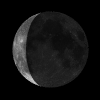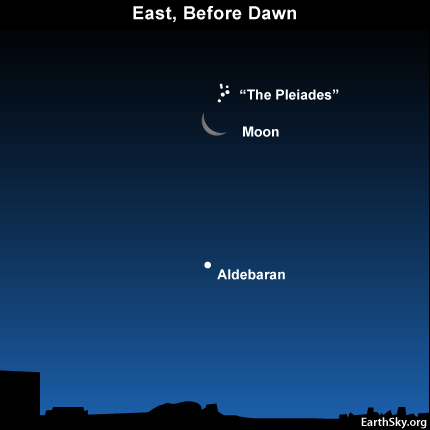Courtesy of EarthSky
A Clear Voice for Science
www.EarthSky.org

 Put your coffee pot on a timer and set your alarm for a couple of hours before sunrise, because you are going to want to get up early tomorrow. In the dark eastern skies before dawn tomorrow, the crescent moon passes near the Pleiades star cluster. The best views are from the North American East Coast and western South America, but chances are good from Europe and the rest of North America as well. In fact, the moon appears near the Pleiades from anywhere on the planet on the morning of the 8th.
Put your coffee pot on a timer and set your alarm for a couple of hours before sunrise, because you are going to want to get up early tomorrow. In the dark eastern skies before dawn tomorrow, the crescent moon passes near the Pleiades star cluster. The best views are from the North American East Coast and western South America, but chances are good from Europe and the rest of North America as well. In fact, the moon appears near the Pleiades from anywhere on the planet on the morning of the 8th.
If you are not familiar with the Pleiades, it will be the fuzzy little patch not far from the moon. Depending on your eyesight and the local conditions, you may not even be able to see any stars in the Pleiades. Sometimes it just looks like a small glowing patch or cloud. Under good conditions, most people can count six or seven stars, and telescopically there are hundreds. Compared to our sun, these stars are all significantly younger, larger and hotter. They are all about 400 light years away, and are bound to each other by gravity.
Even if you are familiar with the Pleiades, also known as the Seven Sisters, you may think that it is just a winter delight. Yet like all other stars these are to be seen in the morning sky just as much as in the evening sky, even though not at the same time of year. In fact, if you know when and where to look, the Pleiades is visible to some extent every night of the year from about mid-June until early the following May. This is not strictly true everywhere on earth, however, because visibility of the Pleiades is more restricted in the southern hemisphere (it can’t be seen at all in Antarctica), and complicated in north polar regions due to long periods of daylight. For several weeks before and after May 20, the Sun is located too close to the Pleiades in the sky for the cluster to be seen easily.
For many of us in the northern hemisphere, the Pleiades is a harbinger of cooler weather, since it is first seen in the early evening sky in October. So to view it during the heat of July is a welcome confirmation that this, too, shall change.
Written by Larry Sessions
Astronomy Picture of the Day from NASA/JPL
U.S. Naval Observator Astronomical Information center
The York County Astronomical Society
 Print This Post
Print This Post








